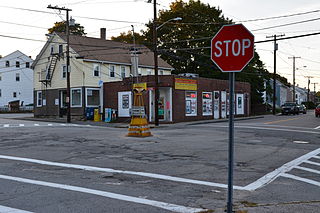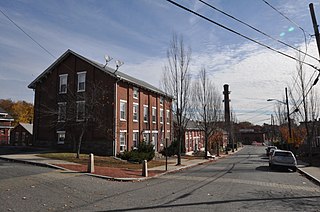
Lincoln is a town in Providence County, Rhode Island, United States. The population was 21,105 at the 2010 census. Lincoln is located in northeastern Rhode Island, north of Providence. Lincoln is part of the Providence metropolitan statistical area and the Greater Boston combined statistical area.
Route 146 is a limited-access road in the U.S. state of Rhode Island, maintained by the Rhode Island Department of Transportation (RIDOT). Spanning approximately 16 miles (26 km) along a north–south axis, it links the cities of Providence, Woonsocket, and Worcester, Massachusetts.

The Moshassuck River is a river in the U.S. state of Rhode Island. It flows 8.9 miles (14.3 km) from the town of Lincoln to the city of Providence. There are six dams along the river's length.

The North Burial Ground is a 110-acre (0.45 km2) cemetery in Providence, Rhode Island dating to 1700, the first public cemetery in Providence. It is located north of downtown Providence, bounded by North Main Street, Branch Avenue, the Moshassuck River, and Cemetery Street. Its main entrance is at the junction of Branch and North Main. The burial ground is one of the larger municipal cemeteries in Southern New England, and it accepts 220 to 225 burials per year.

The Griggsville Landing Lime Kiln is located near village of Valley City, Illinois in Pike County. The periodic lime kiln is listed on the National Register of Historic Places, a designation it gained in August 1999. It is actually within the boundaries of the Ray Norbut State Fish and Wildlife Area. The kiln represents an example of an 1850s lime kiln, one of the best-preserved examples of such a kiln. In its heyday the kiln's raw product would have been quicklime. The kiln is one of twelve Pike County sites included in the National Register of Historic Places. Some other examples are the Lyman Scott House, in Summer Hill and the New Philadelphia Town Site, somewhere near Barry, Illinois.

Buffalo Grove Lime Kiln is one of two old lime kilns in Illinois listed on the National Register of Historic Places. The other is the Griggsville Landing Lime Kiln in Pike County. Buffalo Grove Lime Kiln is located near the Ogle County city of Polo. When in use, the kiln would have produced raw quicklime. The lime kiln was added to the National Register in 2002.

Lime Rock (Limerock) is a village and historic district in Lincoln, Providence County, Rhode Island, United States, near Rhode Island Route 146. The village was named after the limestone quarries in the area, which started in the 17th century, and continue to the present where Conklin Limestone Company now operates. Because of the abundance of limestone in the area many houses had massive end chimneys and were called "stone enders," a distinctly Rhode Island style of architecture. The historic district includes 21 historically significant properties in an area extending from Wilbur Road, just west of its junction with Old Louisquisset Pike, eastward to Great Road, and then along Great Road as far as Simon Sayles Road. Among these properties are three quarries, and the ruins of three old lime kilns. It was listed on the National Register of Historic Places in 1974.

The Battle of Rhode Island Site is the partially preserved location of the Battle of Rhode Island, fought August 29, 1778 during the American Revolutionary War. The battle took place in the town of Portsmouth, Rhode Island, located on Aquidneck Island north of Newport, and was the only major action of the war that took place in Rhode Island. It was also significant as the only battle of the war in which an entirely segregated unit of African-American soldiers fought. At the time of the action, the 1st Rhode Island Regiment consisted of companies of locally recruited African Americans with white officers. The two main areas associated with the battle were designated a National Historic Landmark in 1974.

Albion is a village and historic district in Lincoln, Rhode Island, in the United States.

Lonsdale is a village and historic district in Lincoln and Cumberland, Providence County, Rhode Island, United States, near Rhode Island Route 146 and Route 95. The village was originally part of the town of Smithfield until Lincoln was created in the 1870s, and was originally centered on the Lincoln side of the river. William Blaxton settled in the area in 1635. In the nineteenth and early twentieth centuries, Lonsdale was home to several manufacturers including the Lonsdale Company's Bleachery, and the Ann & Hope mill was also located in the village in Cumberland.

The Ashton Historic District is a historic district in Cumberland, Rhode Island. The district consists of a mill and an adjacent mill village that was built for the workers of the mill. It lies between Mendon Road, Scott Road, Angell Road, Store Hill Road, Front Street and Middle Street. The district was added to the National Register of Historic Places on November 1, 1984.

The Elliot–Harris–Miner House is an historic house located at 1406 Old Louisquisset Pike in Lincoln, Rhode Island. It is a rambling three-section structure, whose main block is 2-1/2 stories tall with a cross-gable roof with bracketed eaves. The oldest portion of the house, however, was at its rear: it was originally a 1-1/2 story Cape style structure built c. 1710, but this has been torn down and replaced by a garage with a cross-gable roof matching that of the main block. These two sections are joined by a third section with a gable roof. The rear section was believed to be the oldest surviving Cape in Lincoln.

The Jenckes House is a historic house at 1730 Old Louisquisset Pike in Lincoln, Rhode Island, United States. It is a 2 1⁄2-story timber-frame structure, five bays wide, with a large central chimney. The main entrance is flanked by pilasters and topped by a transom window and heavy molded cap. Additions extend the house to the south and northwest. The main block is estimated to have been built around 1760, by a member of the locally prominent Jenckes family.

The Wanskuck Historic District is a historic district in the city of Providence, Rhode Island encompassing a mill village with more than two hundred years of history. As early as the mid-18th century, mills stood on the West River in northern Providence, a development which continued with the rise of industrialization in the 19th century. The mill village of Wanskuck is organized around three thoroughfares: Branch Street, Veazie Street, and Woodward Road, and is roughly bounded on the east by Louisquisset Pike and to the northwest by the city line with North Providence. The West River runs through the district, with its banks lined by two late-19th-century mill complexes. The village area includes a variety of examples of mill worker housing, from duplexes to rowhouses, as well as two church complexes and a community hall built in 1884 by the Wanskuck Company.
Jenckes House may refer to either of two houses in the U.S. state of Rhode Island, both of which are listed on the National Register of Historic Places:

The Civil War Monuments in Washington, D.C. are a group of seventeen, outdoor statues which are spread out through much of central and northwest Washington, D.C. The statues depict 11 Union generals and formerly included one Confederate general, Albert Pike, who was depicted as a Mason and not as a general. The Pike statue was torn down on June 19, 2020, as part of the George Floyd protests. Two Union admirals are honored, although Admiral Samuel Francis DuPont's statue was removed to Wilmington, Delaware, and he is now honored with a fountain. Other statues depict nuns, peace, emancipation, and the Grand Army of the Republic.

The Jenckes House is a historic house at 81 Jenckes Hill Road in Lincoln, Rhode Island. It is a 1-1/2 story wood frame structure, five bays wide, with a central chimney. A 20th-century screened porch extends to the right side of the house, and a modern kitchen ell extends to the rear. The house is an 18th-century construction by a member of the locally prominent Jenckes family.

Louisquisset is a village in Lincoln, Rhode Island and North Providence, Rhode Island. The area was first settled in the 1660s when the colonial Providence government granted land to John Whipple and other settlers to acquire land title from the Native Americans in the area. In 1682 Old Louisquisset Pike was laid out to serve the main road through the area connecting Providence to Limerock and the old road continues to serve travellers as modern day Rhode Island Route 146 and Rhode Island Route 246. Louisquisset Country Club and other businesses in the area continue to use the Louisquisset name. Many historic buildings are preserved in the region, including: the seventeenth century Jenckes House on Old Louisquisset Pike.















